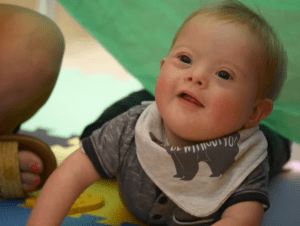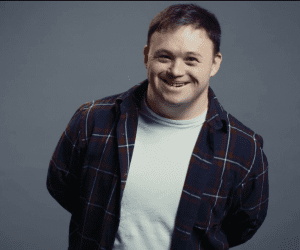What is Down’s Syndrome?
Down’s syndrome is a genetic condition caused by the presence of a full or partial third copy of chromosome 21 in the body’s cells. It is sometimes shortened to “Ds” and in some other countries it’s called Down syndrome. It is named after the British doctor who first recognised it in 1886, Dr John Langdon Down.
People who have Ds are not all the same; every person who has the conditions is as individual as everyone else in the population and have more in common with their families than with another person who has the condition.
The word Syndrome means a set of signs and features that are found together. This is the same for any syndrome not just Down’s syndrome.
Approximately one in every 1,000 babies is born with Down’s syndrome and in Scotland it is estimated that there are 70 babies born with Down’s syndrome each year with the total number of people living with Down’s syndrome in Scotland estimated to be 4,500.
 Down’s syndrome is the most frequently recognised form of learning disability. A learning disability affects a person’s ability to learn, it does not mean they cannot learn. Children with Down’s syndrome follow the same developmental path as for all children and individuals have the same range of feelings and emotions as we all do. Most importantly, everyone who has Down’s syndrome is a unique individual, full of potential.
Down’s syndrome is the most frequently recognised form of learning disability. A learning disability affects a person’s ability to learn, it does not mean they cannot learn. Children with Down’s syndrome follow the same developmental path as for all children and individuals have the same range of feelings and emotions as we all do. Most importantly, everyone who has Down’s syndrome is a unique individual, full of potential.
What causes Down’s syndrome?
Down’s syndrome usually occurs randomly at the time of conception and affects males and females alike. It is rarely hereditary and nothing either parents did before or during pregnancy can have caused it.
Inside the cells in our bodies we all have chromosomes which contain information that make each of us unique, such as our eye colour, hair colour and height.
 Most people have 46 chromosomes inside every cell of their body which go together in twenty-three pairs – at conception babies receive 23 chromosomes from mum and 23 from dad which make up the 46 pairs.
Most people have 46 chromosomes inside every cell of their body which go together in twenty-three pairs – at conception babies receive 23 chromosomes from mum and 23 from dad which make up the 46 pairs.
People born with Down’s Syndrome have an extra full or partial copy of chromosome 21 which means they have 47 chromosomes in the cells in their body – one extra chromosome that randomly happens. It is this extra chromosome 21 that causes the characteristics of the condition.
There are three types of Down’s syndrome: Trisomy 21, Translocation and Mosaic Down’s syndrome.
Trisomy 21 Down’s syndrome
The most common type of Down’s syndrome (occurring in about 94% of people with Ds) is Trisomy 21, so called as all the cells in the person’s body have a full extra copy of chromosome 21, so there are 3 copies of chromosome 21 in every cell.
Around 4% of people with Down’s syndrome have translocation Down’s syndrome. This is when the extra chromosome 21 material translocates or moves itself to attach to another chromosome in the cell, this is typically chromosome 14 or 17.
Mosaic Down’s syndrome
Mosaic Down’s syndrome occurs when only some of the cells in the body have the extra chromosome and some cells don’t. About 2% of people with Down’s syndrome have this type. People with mosaic Down’s syndrome are likely to have milder learning disabilities.
DS is a lifelong condition and there is no cure; however, there are many ways to ensure that each individual with Down’s syndrome is given the right type and amount of support that they need to develop to their full potential. Today the average life expectancy for a person with Ds is about 60 years old with a small number of people living into their 70s and beyond.
Please find below a selection of videos from children, young people and adults as well as their parents and carers sharing their lived experience of Down’s syndrome.
If you are a new or expectant parent of a baby with Down’s syndrome we have more information about Down’s syndrome and what to expect, for information for expectant parents click here for information for new parents click here.




